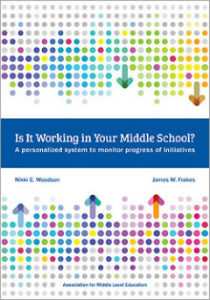Monitoring the Progress of School Initiatives
Is It Working in Your Middle School? A personalized system to monitor progress of initiatives
By Nikki C. Woodson and James W. Frakes
(Association for Middle Level Education, 2016 – Learn more)

Quick! Grab a pen or pencil or open up a new document on your computer. Ready? Good. Now, write down the name of every initiative your school or district has adopted since you started working there.

All finished? Okay. Now, circle all of the ones that you are sure are improving student learning and growth. How many initiatives did you list? Five? Ten? Twenty? More? How many did you circle? One? Two? Zero?
If there is anything that school leaders and policymakers are frustratingly good at doing, it is coming up with new initiatives for classrooms, schools, and districts. Whether the initiatives are focused on academics, behavior, instruction, culture, family engagement, teacher quality, or any number of other possibilities, there is not a school in the nation that doesn’t have at least one new initiative put into place every year.
Once initiatives are in place…
But what do we do after we initiate the initiative? How do we know if it is actually making a difference? Are we even bothering to check? Or do we just start something new and keep doing it mechanically, perhaps thinking to ourselves that this, too, shall pass? Has the Shiny New Thing become so commonplace that we don’t even care if it works or not?
Dr. Nikki C. Woodson, an educational leader, and James W. Frakes, a business consultant who has spent much of his career working with the manufacturing industry, both believe that the problem with initiatives is not the initiatives themselves, but the lack of intentionality and monitoring.
A framework for follow-up
In their book, Is It Working in Your Middle School?, they provide a simple framework for identifying appropriate initiatives and monitoring them with consistency so that teachers, leaders, and other stakeholders can separate the wheat from the chaff and put into place programs, policies, and practices that will lead to meaningful, lasting changes in your school.
While focusing on middle schools, the authors are quick to note that their framework, based on proven quality assurance processes, can be used in any school setting and, indeed, in any organization that wants to know if what they are doing is actually making a difference.
The authors’ process will help anyone with an interest in improving their school to identify all of the current initiatives or programs in place, eliminate the ones that have no discernible purpose, set S.M.A.R.T. goals, identify quantifiable strategies, assess the efficacy of the strategies, monitor for success, and plan for next steps to make the school improvement process truly continuous.
Helpful templates
To help the reader through the process, Woodson and Frakes provide templates for reflection, goal setting, planning, and monitoring that can be copied from the book or downloaded for free through a website. They also provide a case study to model how their framework has been used to change a middle school’s approach to improvement plan goals.
Classrooms, schools, and districts are constantly adapting as they try to keep up with the latest research, best practices, and the ever-changing landscape of education in the 21st century. These adaptations are not, in and of themselves, a bad thing; they can push a school to grow and improve.
Growth and improvement will only happen, though, if teachers and leaders work together to monitor the changes and keep asking each other two simple questions: Is it working? How do we know?
Your guide to evaluating progress
If you are concerned that the programs you are using in your classroom, school, and/or district are not making a difference in student achievement but you’re are not sure how to prove it — or if you are convinced that your programs are working but need evidence to justify continuing them — this is the book for you!
You may not be able to stem the tide of Shiny New Things coming your way, but you will be able to show which ones are making a difference in the lives of your students and which ones are just passing fads.
Alex T. Valencic is a fourth grade teacher in Urbana, Illinois. He has taught professionally for nine years. While he typically has a full head of thick, curly hair, he keeps getting it shaved off to encourage his students to tackle academic challenges such as collectively reading 1,000,000 minutes or completing 1,000,000 math problems! You can learn more about Alex’s classroom happenings by visiting his blog Adventures in Teaching Fourth or by following him on Twitter @alextvalencic.






























